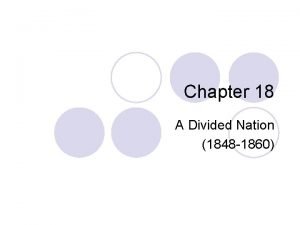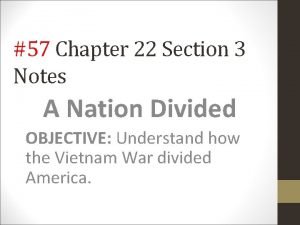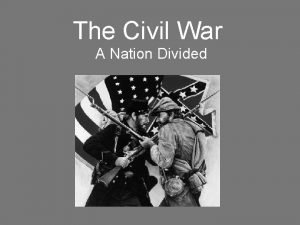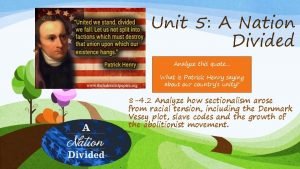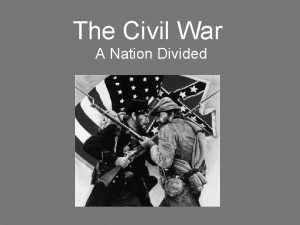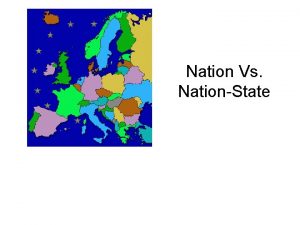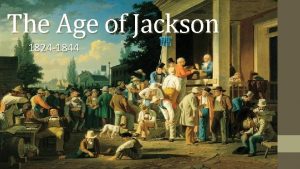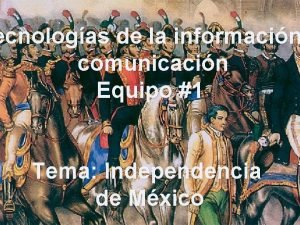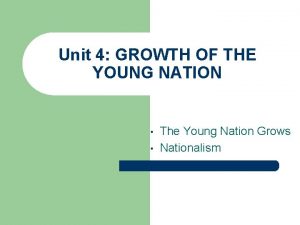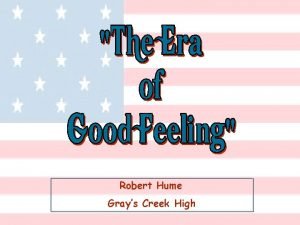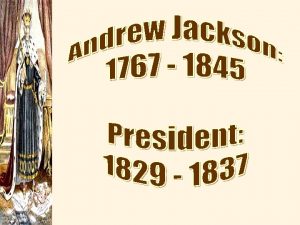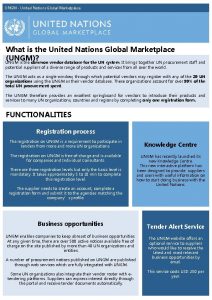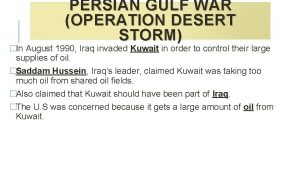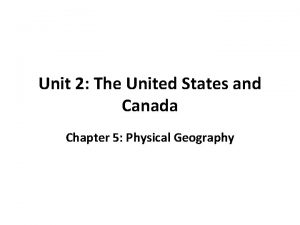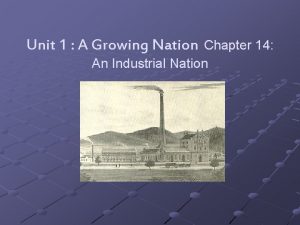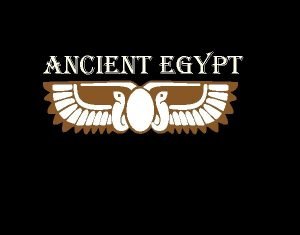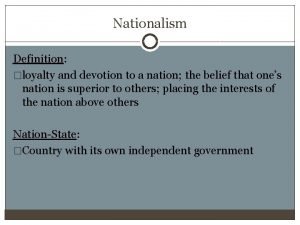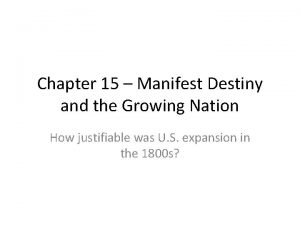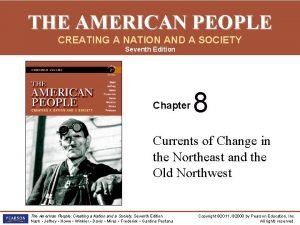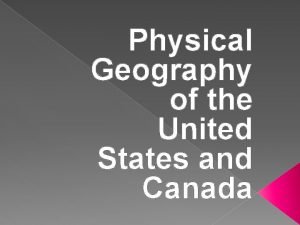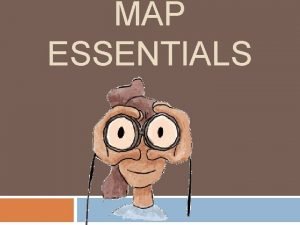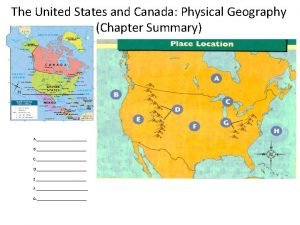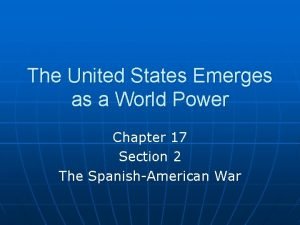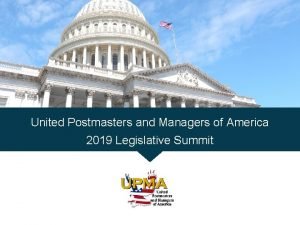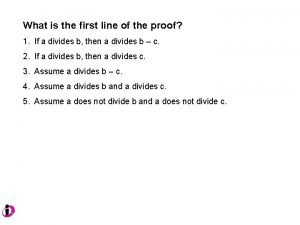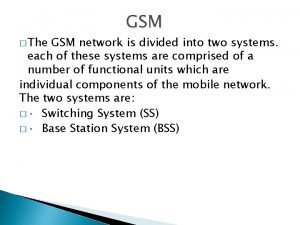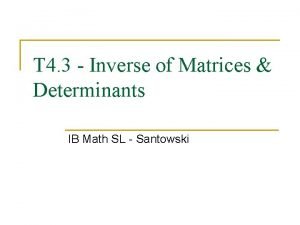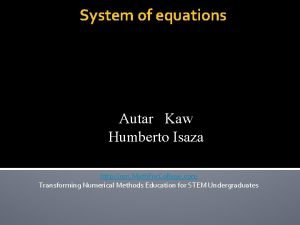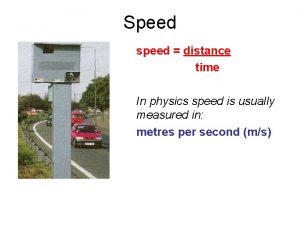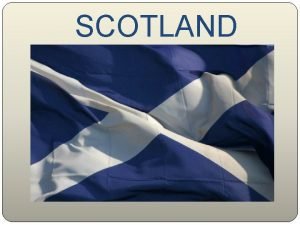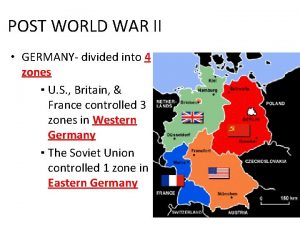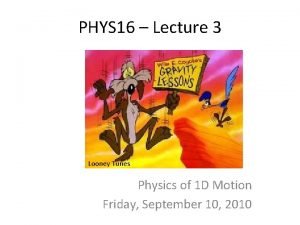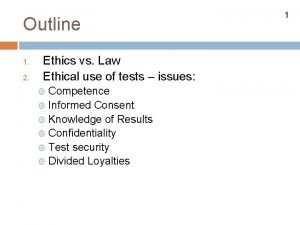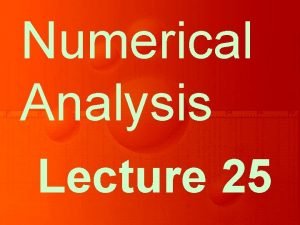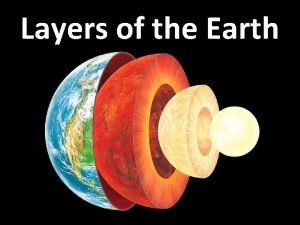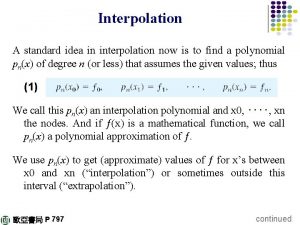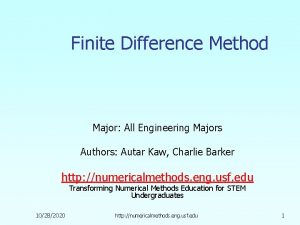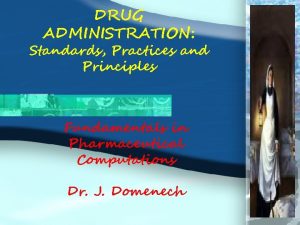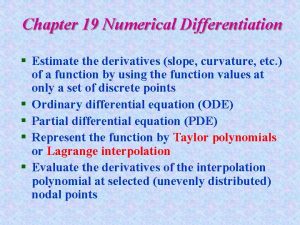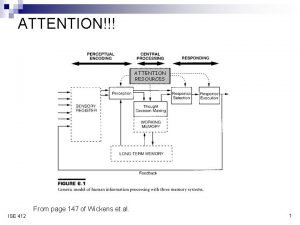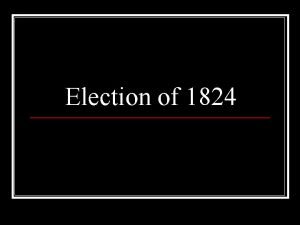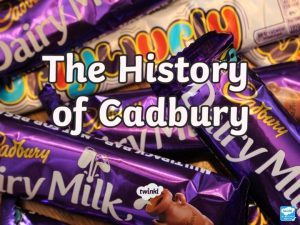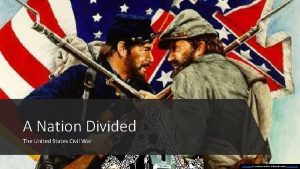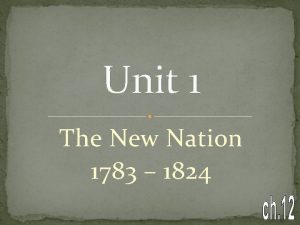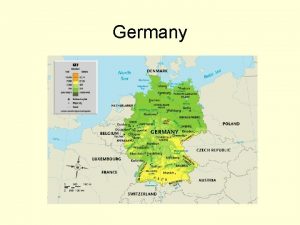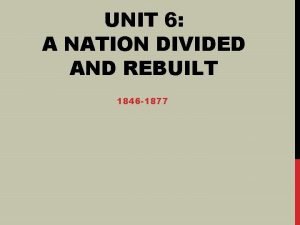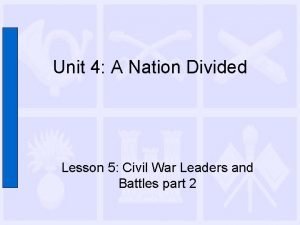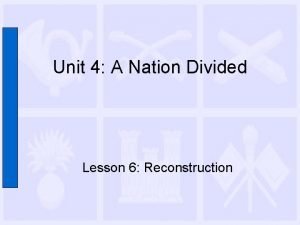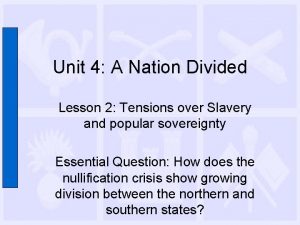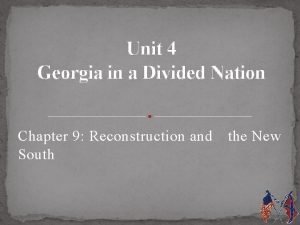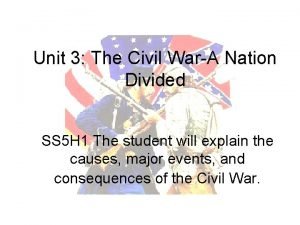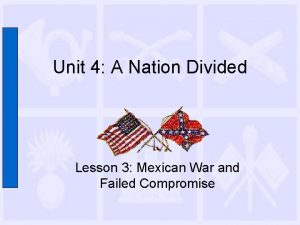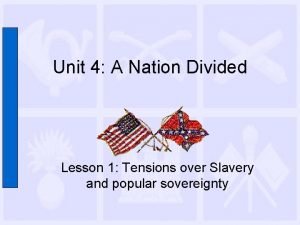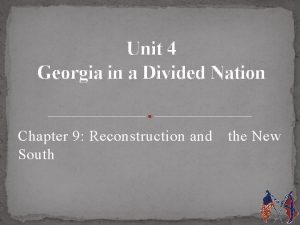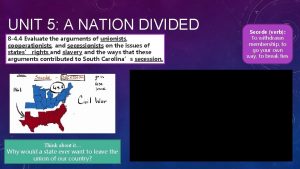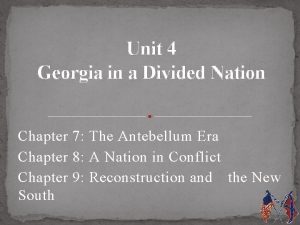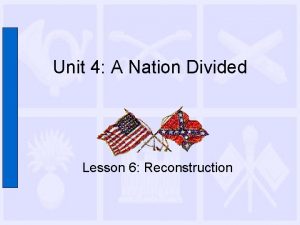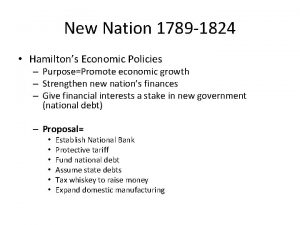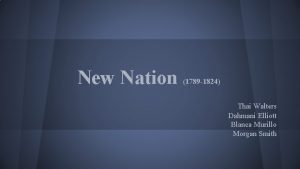Unit 4 A United and Divided Nation 1824






























![The 1836 Election Results Martin Van Buren “Old Kinderhook” [O. K. ] The 1836 Election Results Martin Van Buren “Old Kinderhook” [O. K. ]](https://slidetodoc.com/presentation_image_h2/abb27bfca3c43d6d65b42607ccf55880/image-31.jpg)


























































- Slides: 89

Unit 4 : A United and Divided Nation (1824 -1853) AMERICA EXPANDS IN THE FIRST HALF OF THE 19 TH CENTURY

Wednesday, March 22 nd l CNN-warm up: – • • Think about the term ‘corrupt bargain’. What do you think that means? Break it down separately…what does ‘corrupt’ mean? What does it mean to ‘strike a bargain’? Go over test-discuss corrections change 1824 election notes Video-JQ Adams Begin graphic team work

THE AGE OF JACKSON: SECTION 1

Election of 1824 l J. Q. Adams H. Clay 4 way race for President for D-R – – l Jackson won the popular vote but… – Crawford J. Q. Adams, H. Clay, A. Jackson, W. Crawford All ran as Dem-Rep. No one had electoral majority

Election of 1824 l l House of Reps. deadlocked Clay makes a deal with JQA to throw the votes to JQA if he chooses Clay to become Sec. of State JQA makes the deal and he becomes President Jackson calls the deal a “corrupt bargain”

Results of the 1824 Election A “Corrupt Bargain? ”

Increased Democratization between 1824 -1828 v White male suffrage increased v No more land requirement to vote v Party nominating committees. v Voters chose their state’s slate of Presidential electors. v Rise of Third Parties. v Popular campaigning (parades, rallies, floats, etc. ) v Two-party system returned in the 1828 election: § National Republicans – John Quincy Adams § Jacksonian-Democrats (1828) – A. Jackson

Election of 1828 l l l JQA ran for Republicans Jackson ran for Democrats Jackson wins in a huge landslide

1828 Election Results

Thursday, March 23 rd l l CNN Jackson 1 st Bell 1 st Block Nat’lism v Sectionalism 2 ND Chance Enjoy your long weekend!!! Breakfast 2 nd Block 3 rd Block 4 th Block Dismissal 7: 05 7: 15 -8: 07 -8: 14 -9: 06 9: 1110: 03 10: 0811: 00

JACKSONIAN DEMOCRACY l l l As part of his political philosophy, Jackson sought to grant political power to the common people Called The Spoils System or Jacksonian Democracy, Jackson hired his own supporters to replace the previous administration’s staff Jackson gave away many jobs to his friends and political allies

Jackson’s Faith in the “Common Man” v Intense distrust of Eastern “establishment, ” monopolies, & special privilege. v His heart & soul was with the “plain folk. ” v Belief that the common man was capable of uncommon achievements.

• Indian Removal Jackson’s Goal? o • Move Native Americans off land in order for settlement 1830 Indian Removal Act o Native Americans to be moved to Oklahoma

INDIAN REMOVAL - 1830

Worcester v. Georgia 1832 Samuel Worcester l Georgia trying to move Cherokee off lands l Worcester sues in order for tribe to remain l Cherokee can remain

l l Jackson: John Marshall has made his decision, now let him enforce it! Jackson orders the US army to relocate the Native Americans to Oklahoma = Trail of Tears

Indian Removal

TARIFF OF “ABOMINATIONS” l THE NORTH l TARIFFS THE SOUTH In 1824 and again in 1828, Congress increased the Import Tariff of 1816 Southerners called the 1828 Tariff, “a Tariff of Abominations, ” and blamed it for economic problems in the South


South Carolina Nullification Crisis l l VP Calhoun resigns in 1832 SC nullified tariffs of 1828 and 1832 Jackson is FURIOUS Jackson passes Force Bill (1833) – Use federal army and navy against SC to enforce laws Henry Clay (“The Great Compromiser”) proposes a bill to lower gradually over a 10 year period. Crisis ends – l l “Ill hang that treasonous Calhoun” - Andrew Jackson l

Nationalism vs Sectionalism l First-separate the terms by either placing them in a ‘nationalism’ category, or ‘sectionalism’ one. Then determine whether they fall into the Economic, Social, or Political category and label them as such. Feel free to research all topics/terms. Use a pencil, in case you have to erase or correct anything. Review definition of these two words…

First wave of terms to separate: l l l l l Political parties Expansion Religion Art Slavery War of 1812 Internal improvements Economy National bank American System Protective tariffs Monroe Doctrine Literature Nullification Crisis Reform Missouri Compromise Industrial revolution Election of 1824

l l l l l Mexican War Compromise of 1850 Adams Onis Treaty Era of Good feelings Tariffs Immigration 2 nd bank and Jackson’s war Abolition Nativism

Monday, March 27 th l l l CNN Quiz 1 Unit 4 Removal and Nullification Notes-Jackson and the Bank Jackson Video pt 1 Nationalism v Sectionalism and Expansion Maps

Jackson vs. Bank of the United States l l Bank’s charter up for renewal in 1836 Jackson hated the Bank of U. S. – – Jackson felt Bank was Unconstitutional – even though Mc. Cullough v. Maryland said it was Constitutional Called it a “MONSTER”

Jackson vs. Bank of the United States l l Jackson vetoed the Bank re-charter Federal money put into “pet banks” – State banks

Jackson Killing the “Monster”

The Downfall of “Monster Bank”

An 1832 Cartoon: “King Andrew”?

Legacy of Jackson l l l Whig Party Forms (anti. Jackson) Modern Party system Nominating convention Expanded voting rights Strong executive power(Veto) Emphasis on states’ rights (except for nullification)
![The 1836 Election Results Martin Van Buren Old Kinderhook O K The 1836 Election Results Martin Van Buren “Old Kinderhook” [O. K. ]](https://slidetodoc.com/presentation_image_h2/abb27bfca3c43d6d65b42607ccf55880/image-31.jpg)
The 1836 Election Results Martin Van Buren “Old Kinderhook” [O. K. ]

Tuesday, March 28 th CNN-warm up-read the quote below, what do you think this means? How can we do this? l Debate activity l Corrections-hard copy l Nationalism v Sectionalism “America is not anything if it consists of each of us. It is something only if it consists of ALL of us”-Woodrow Wilson l

Wednesday, March 29 th l l l CNN Jackson Quiz Outline info-regional differences and expansion Nationalism v Sectionalism Jackson Jeopardy

Thursday, March 30 th l l CNN Reform Notes Intro to Reform Project Begin “Amistad”

PANIC OF 1837 l In 1836, Democrat Martin Van Buren won the Presidency l The Panic of 1837 set in and many banks closed, accounts went bankrupted, and unemployment soared MARTIN VAN BUREN 1837 -1841

HARRISON & TYLER l l HARRISON 1841 TYLER 1841 -1845 l Whig William Henry Harrison defeated Democrat Van Buren in the election of 1840 Harrison, known as “Tippecanoe” for a battle he won against natives, died a month into his term His VP, John Tyler became president

REFORMING AMERICAN SOCIETY: SECTION 2 l l The Second Great Awakening spread Christianity through revival meetings These and other religions became the impetus for reforming society RALPH WALDO EMERSON

TURNER’S REBELLION l l Turner plans his rebellion The vast majority of African. Americans were enslaved in the South and were subjected to constant degradation Some rebelled against their condition Most famous revolt was led by Virginia slave Nat Turner led 50 followers in a revolt killing 60 whites – he was caught and executed

THE ABOLITIONIST MOVEMENT l l l 1820 s: Abolitionist movement to free African Americans from slavery arose Leader was a white radical named William Lloyd Garrison The Liberator

FREDERICK DOUGLASS: AFRICAN AMERICAN LEADER l l Freed slave, Frederick Douglass escaped from bondage and became an eloquent abolitionist (critic of slavery) leader He began an anti-slavery newspaper called, North Star – named after the star that guided runaway slaves to freedom

WOMEN AND REFORM l l l From abolition to education, women worked actively in all reform movements Throughout the 1800 s opportunity for women to become educated increased 1833: Oberlin College became first coed institution

WOMEN’S RIGHTS MOVEMENT EMERGES l l l Reform movements of the 19 th century spurred the development of a Women’s movement For example, Elizabeth Cady Stanton and Lucretia Mott had both been ardent abolitionists In 1848, more than 300 women participated in a Women’s Right convention in Seneca Falls, N. Y.

Two pioneers in women’s rights: Elizabeth Cady Stanton (left) and Susan B. Anthony

The Reform Era - Temperance • Temperance Movement movement to reduce the use of alcoholic beverages alcohol linked to sickness, poverty, and breakup of families by the mid 1800 s, many states outlaw alcohol

Friday (woohoo!), March 31 st l l l CNN Prison reform notes Amistad

The Reform Era – Prison Reform • 1831: French writer Alexis de Tocqueville visits prisons in the U. S. …”U. S. gives the most extended liberty… prisons in the U. S. offer the spectacle of the most complete despotism” • Dorothea Dix was the greatest reformer for prisoners and the mentally ill. wanted to create separate facilities for both by the time of her death, 100 facilities were established in the U. S.

The Reform Era - Education • Education reformers wanted to improve public schools. no attendance requirement (except for Ma. and Vt. ) schools not divided by grade levels • Greatest reform leader in education was Horace Mann established teacher training programs improved curriculum doubled money Massachusetts spent on schools • 1 st Public University – UNC Chapel Hill - 1795

Transcendentalism & Utopianism • Transcendentalist Movement A philosophical & literary movement that emphasized living a simple life and celebrating truth found in nature. • Two leading transcendentalists were Ralph Waldo Emerson and Henry David Thoreau. Both believed that people should be selfreliant and trust their intuition.

Transcendentalism & Utopianism • Henry David Thoreau People should act according to their own beliefs even if it meant breaking the law Civil Disobedience: Peacefully refusing to obey the law (Ex. Martin Luther King Jr. and Gandhi) Went to jail for refusing to pay taxes to government because government allowed slavery and fighting war with Mexico.

Transcendentalism & Nationalism in Literature • • • Nathaniel Hawthorne: Scarlet Letter Washington Irving: Legend of Sleepy Hollow Noah Webster: American Dictionary Edgar Allen Poe: The Raven James Fenimore Cooper: Last of the Mohicans

What is Manifest Destiny? § First coined by newspaper editor, John O’Sullivan in 1845. § The belief that America had the god given right to expand the U. S. ’s borders from “sea to shining sea” by John Gast, 1872

Original 13 Colonies Ü When? - 1783 Ü From Where? - Great Britain Ü Why? - U. S. won Revolutionary War

Louisiana Purchase Ü When? - 1803 Ü From Where? - France Ü Why? - Napoleon needed the money **Effect: - U. S. doubles size

Adams-Onis Treaty Ü When? - 1819 Ü From Where? - Spain Ü Why? - Andrew Jackson invaded

Overland Immigration to the West § Between 1840 and 1860, more than 250, 000 people made the trek westward.

The Oregon Trail (1840 s)

The Oregon Trail § Started in Independence, Missouri § Ended in Portland, Oregon § Traveled by wheeled covered Conestoga Wagons § Took 4 -6 months § Many people died

The Oregon Trail

The Doomed Donner Party April, 1846 – April, 1847

The Doomed Donner Party CANNIBALISM ! Margaret Breen James Reed & Wife Patrick Breen John Breen § Of the 83 members of the Donner Party, only 45 survived to get to California!

Oregon Territory Ü When? - 1846 Ü From Where? - Great Britain Ü Why? - President Polk wanted to annex Oregon Territory - want 54 o 40’ (or Fight) BUT settled for 49 th parallel

Mormons to Utah § 1846 -1857 § Joseph Smith leads Mormons from NY to Nauvoo, Illinois 1839 § People angry about Mormon polygamy § Smith put in jail in 1844 and murdered § Brigham Young leads Mormons to Utah

Expansion in Texas Mrs. King CCHS

Mexico Under Spanish Rule ◊ Spain controlled Mexico for 300 years ◊ 1821: Mexico wins their independence from Spain

Americans in Mexican Texas ◊ Americans are invited to the region of Tejas by the Mexican government in 1821 Empressarios (land grant agents) offer land to U. S. settlers 13 cents/acre ◊ MAD DASH TO MEXICO!!! made by Americans & Europeans

Stephen F. Austin ◊ Most successful empresario gathered 300 families to move to Texas (Old Three Hundred) they were exempt from paying taxes and received 177 acres ◊ By 1830, 20, 000 Americans moved to Texas

U. S. Offers to Buy Texas ◊ U. S. slogan: “Go to Texas” ◊ Americans wanting to extend U. S. boundaries to the Rio Grande River ◊ John Quincy Adams offers Mexico $1 million ◊ Andrew Jackson offers Mexico $5 million ◊ Mexico refuses regrets encouraging Americans to settle there

Conflict with Mexico ◊ Mexico begins to enforce their laws on white settlers in Texas ◊ Mexican general Antonio Lopez de Santa Anna becomes dictator in Mexico he intends to drive Americans out of Texas ◊ Santa Anna has Stephen F. Austin arrested for promoting revolution rebellions break out Santa Anna

Texans Take Action ◊ December 1835 - Texans occupied San Antonio and take up positions in an old Spanish mission called Alamo

The Alamo

Siege at The Alamo ◊ February 23 rd, 1836 Santa Anna laid siege to the Alamo ◊ Texans poorly equipped less than 200 vs. 6, 000 Mexican troops ◊ Texans declared independence for the Republic of Texas on March 2, 1836. during the siege ◊ Santa Anna and his men swarm the garrison 187 Texans die including Jim Bowie, Davy Crockett and Commander William Travis

Davey Crockett’s Last Stand

Texan Independence ◊ Sam Houston made Commander of Texan Army ◊ Battle of San Jacinto: Battle Cry of “ Remember the Alamo” The battle lasted only 18 minutes. Texans killed 630 Mexican troops and captured 700 more. ◊ The day after the Battle of San Jacinto, the Texans captured Santa Anna and made him sign a treaty granting Texas independence. Sam Houston

Battle of San Jacinto

Treaty of Velasco ◊ May 14 th, 1836 ◊ Texas becomes an independent country ◊ Sam Houston becomes president of Texas - Texas referred to as “The Lone Star Republic” ◊ 1838: Texas asks U. S. to be annexed issue of slavery (sectionalism) will keep Texas out of U. S. until 1845 ◊ Texas will continue to dispute boundary with Mexico

Treaty of Velasco

9 -4: The War with Mexico Mr. King CCHS

Factors Leading to War • Manifest Destiny President Polk’s drive to expand • Annexation of Texas - 1845 border dispute… Nueces River or Rio Grande River?

Gen. Zachary Taylor * First battle of the war. Gen. Santa Anna

Attitudes Toward War • South: In favor of War! extend slavery increase power in Congress counter Wilmot Proviso (1846 - proposed amendment prohibiting slavery in lands gained from Mexico) • North: Against the War! viewed as plot to extend slavery Abraham Lincoln against the war Henry David Thoreau: refused Congressman David Wilmot (D-PA)

Mexican War – The Beginning • The U. S. declared war on Mexico in 1846, shortly after annexing Texas.

During the War… § June 15, 1846: Am. citizens led a revolt similar to Texans to seize town of Sonoma, Ca. Bear Flag of the California Republic § Captain John C. Freemont helps California stay out of Mexican hands

During the War… § February 22, 1847: Battle of Buena Vista U. S. : Zachary Taylor w/ 4, 600 Mexico: Santa Anna w/ § Taylor 20, 000 holds his ground uses this as his presidential campaign in 1848

Treaty of Guadalupe-Hidalgo, 1848 § Mexico gave up claims to Texas above the Rio Grande River. § Mexico gave up areas of California, Nevada, Utah, New Mexico, Arizona, Colorado and part of Texas, Oklahoma, Kansas and Wyoming § U. S. gave Mexico $18, 250, 000 ($461, 000 today) and agreed to pay the claims of American citizens against Mexico (over $3, 500, 000).

The Mexican Cession

Forty. Niners Headed to California • 1849 – discovery of gold in California

California Gold Rush, 1849 49 er’s

Gadsden’s Purchase Ü When? - 1853 Ü From Where? - Mexico Ü Why? - U. S. wanted to build railroad thru that area… paid Mexico $10 million

UNITED STATES EXPANSION BY 1853 - MANIFEST DESTINY
 United nations department of safety and security
United nations department of safety and security A divided nation section 4
A divided nation section 4 A nation divided chapter 22 section 3
A nation divided chapter 22 section 3 A nation divided: north vs. south
A nation divided: north vs. south Analyze this quote
Analyze this quote A nation divided north vs south answer key
A nation divided north vs south answer key State vs nation
State vs nation Country vs nation
Country vs nation State vs nation
State vs nation The romantic age (1798 to 1824)
The romantic age (1798 to 1824) Components of accenture delivery suite (ads)
Components of accenture delivery suite (ads) Guided reading & analysis: the age of jackson, 1824-1844
Guided reading & analysis: the age of jackson, 1824-1844 Constituição 1824
Constituição 1824 The romantic age (1798 to 1824)
The romantic age (1798 to 1824) 19 estados y 5 territorios de méxico en 1824
19 estados y 5 territorios de méxico en 1824 Jim bowie
Jim bowie The age of jackson 1824-1844
The age of jackson 1824-1844 Mexican federal constitution of 1824
Mexican federal constitution of 1824 What is the main idea?
What is the main idea? Election of 1824
Election of 1824 Election of 1824
Election of 1824 Ungm
Ungm United nation
United nation Many _____ people have settled in this megalopolis.
Many _____ people have settled in this megalopolis. Unit 2 the united states and canada worksheet answers
Unit 2 the united states and canada worksheet answers Unit 2 resources a growing nation
Unit 2 resources a growing nation Unit 10, unit 10 review tests, unit 10 general test
Unit 10, unit 10 review tests, unit 10 general test Mother and child divided
Mother and child divided A class divided questions and answers
A class divided questions and answers What are divided powders
What are divided powders Granular powder examples
Granular powder examples What divided upper and lower egypt
What divided upper and lower egypt Divided powders examples
Divided powders examples Pengertian perhatian psikologi
Pengertian perhatian psikologi Periodic table divided in metals nonmetals and metalloids
Periodic table divided in metals nonmetals and metalloids Refers to the loyalty and devotion to a nation
Refers to the loyalty and devotion to a nation Every country and every nation
Every country and every nation Every nation has _________ customs and traditions
Every nation has _________ customs and traditions Travel in a growing nation answer key
Travel in a growing nation answer key A new nation and its growing pains review
A new nation and its growing pains review Topic 2 industry and immigration
Topic 2 industry and immigration Mujaddid alf sani and two nation theory
Mujaddid alf sani and two nation theory Focused opportunistic approach
Focused opportunistic approach Every nation and every country
Every nation and every country The nation and its fragments
The nation and its fragments The american people creating a nation and a society
The american people creating a nation and a society How to label hyp opp adj
How to label hyp opp adj Unit process and unit operation
Unit process and unit operation Difference between unit process and unit operation
Difference between unit process and unit operation Awake united states date and author
Awake united states date and author United states and canada physical map
United states and canada physical map World map with latitude and longitude lines printable
World map with latitude and longitude lines printable Ethics and integrity at the united nations
Ethics and integrity at the united nations Does canada have mountains
Does canada have mountains United states history and government regents
United states history and government regents The united states emerges as a world power
The united states emerges as a world power United postmasters and managers of america
United postmasters and managers of america A divide by b
A divide by b Latin verbs are divided into
Latin verbs are divided into The gsm network is divided into
The gsm network is divided into Find the determinant of the following matrix:
Find the determinant of the following matrix: Can matrices be divided
Can matrices be divided Speed distance time triangle
Speed distance time triangle Volume of solute divided by volume of solution * 100
Volume of solute divided by volume of solution * 100 System software divided into two categories
System software divided into two categories Sign shapes meaning
Sign shapes meaning Seed plants are divided into two groups called
Seed plants are divided into two groups called Scotland is divided into
Scotland is divided into Germany divided after ww2
Germany divided after ww2 Acceleration divided by time
Acceleration divided by time How many generals divided alexander's empire?
How many generals divided alexander's empire? Sfeedtest
Sfeedtest Finely divided catalyst
Finely divided catalyst Four quadrants of the abdomen
Four quadrants of the abdomen Finite divided difference
Finite divided difference Central difference interpolation formula
Central difference interpolation formula Alternating attention vs divided attention
Alternating attention vs divided attention Dividing negative numbers
Dividing negative numbers Long division with 2 digit divisors
Long division with 2 digit divisors What are the 3 layers of earth
What are the 3 layers of earth Lagrange interpolation formula
Lagrange interpolation formula India can be divided into natural regions
India can be divided into natural regions Finite divided difference
Finite divided difference Drug dose calculation formula for child
Drug dose calculation formula for child Desired dose formula
Desired dose formula Dividing fractions word problems
Dividing fractions word problems Distance divided by time
Distance divided by time Derivatives of unequally spaced data
Derivatives of unequally spaced data Lagrange interpolation
Lagrange interpolation Divided attention examples
Divided attention examples

